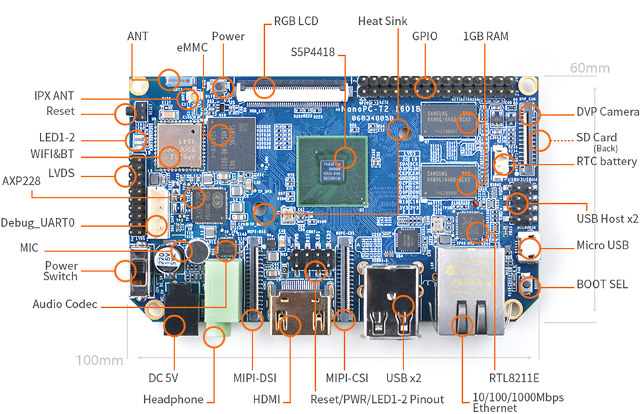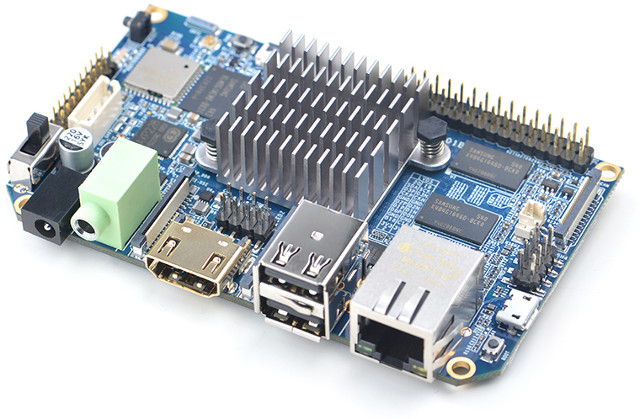FriendlyARM NanoPC-T1 board powered by Samsung Exynos 4412 processor with 1GB RAM and 4GB eMMC flash was unveiled at the start of 2014 for $69. The company has now announced NanoPC-T2 with Samsung S5P4418 processor with 1GB RAM, and 8GB Flash, as well as WiFi and Bluetooth, as Gigabit Ethernet all of which were missing in the first version. NanoPC-T2 also has a power management chip, and a larger heatsink, meaning that it does not suffer from overheating like NanoPi2 according to FriendlyARM.
- SoC – Samsung S5P4418 quad core Cortex A9 processor @ up to 1.4GHz with Mali-400MP GPU
- System Memory – 1GB 32bit DDR3 RAM
- Storage – 8GB eMMC flash, and 1x SD card slot (on the bottom of the board)
- Connectivity – Gigabit Ethernet, 802.11 b/g/n WiFi and Bluetooth LE 4.0 (Ampak AP6212) with on-board chip antenna and 1x IPX antenna connector
- Video Output / Display I/F- 1x HDMI 1.4a, LVDS, MIPI DSI, 0.5 mm pitch SMT FPC seat for type-A full-color LCD (RGB: 8-8-8)
- Audio I/O – HDMI, 3.5mm audio jack, 1x on-board microphone
- Camera – 1x DVP interface, 1x MIPI CSI interface
- USB – 2x USB 2.0 type A host ports; 1x micro USB 2.0 OTG port; 2x USB 2.0 host port via 8-pin header
- Expansions Headers – 30-pin header for GPIO, 8-pin header for power signals, reset and LED 1-2
- Debugging – 4-pin header for serial console
- Misc – Power switch, 1x power & 2x user LEDs, RTC battery header, boot selection button (SD card / eMMC)
- Power Supply – 5V/2A via power barrel; AXP228 PMIC
- Dimension – 100 x 60 mm (6-layer PCB)

The board can run Debian and Android from either anSD card or eMMC flash using the boot selection button. The Wiki page is currently empty, but should eventually have all the technical details needed to get started and more.
NanoPC-T2 board will launch on February 28, 2016 for $59 + shipping on FriendlyARM shop. Individuals based in South and North America will instead be able to purchase it from Andahammer.

Jean-Luc started CNX Software in 2010 as a part-time endeavor, before quitting his job as a software engineering manager, and starting to write daily news, and reviews full time later in 2011.
Support CNX Software! Donate via cryptocurrencies, become a Patron on Patreon, or purchase goods on Amazon or Aliexpress





